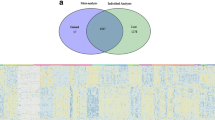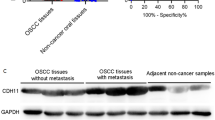Abstract
Oral squamous cell carcinoma (OSCC) is the sixth most common cancer worldwide. Despite progress in therapeutic and surgical treatments, its survival period at 5 years is the lowest among major cancers, and remains unchanged in the last two decades. The growing epidemiological relevance of oral cancer emphasizes the need to better understand the molecular mechanisms underlying this disease and identify predictive tumor markers and therapeutic targets. To this end, we have used the DDRT-PCR analysis to profile the oral tumor transcriptome and identify differentially regulated genes that may be used as potential biomarkers and therapeutic targets. Our DDRT-PCR analysis identified 51 differentially expressed fragments, of which 25 were revalidated by reverse Northern analysis. Northern blot analysis further corroborated these findings for a few genes. In order to ascertain the utility of some of the identified genes as molecular markers and therapeutic targets, semi-quantitative RT-PCR analysis was carried out in a panel of matched oral normal and tumor samples, that confirmed GLTP, PCNA, RBM28, C17orf75 and DIAPH1 as significantly upregulated, whereas TNKS2, PAM and TUBB2C showed significant downregulation in tumor samples. Taken together, our DDRT-PCR analysis has revealed several genes, belonging to diverse cellular pathways, that have been associated with OSCC for the first time. Thus, these genes could be investigated as biomarkers and therapeutic targets for OSCC.



Similar content being viewed by others
References
Notani PN (2000) Epidemiology and prevention of head and neck cancer: a global view. In: Saranath D (ed) Contemporary issues in oral cancer. Oxford University Press, New Delhi, pp 1–29
Nagpal J, Das BR (2003) Oral cancer: reviewing the present understanding of its molecular mechanism and exploring the future directions for its effective management. Oral Oncol 39:213–221
Indian Council of Medical Research (1992) National cancer registry programme: biennial report 1988–89. ICMR, New Delhi
Parker SL, Tong T, Bolden S, Wingo PA (1996) Cancer statistics 1996. CA Cancer J Clin 46:5–27
Landis SH, Murray T, Bolden S, Wingo PA (1999) Cancer statistics 1999. CA Cancer J Clin 49:8–31
Nagler RM (2002) Molecular aspects of oral cancer. Anticancer Res 22:2977–2980
Sheu JJ, Hua CH, Wan L, Lin YJ, Lai MT, Tseng HC, Jinawath N, Tsai MH, Chang NW, Lin CF, Lin CC, Hsieh LJ, Wang TL, IeM S, Tsai FJ (2009) Functional genomic analysis identified epidermal growth factor receptor activation as the most common genetic event in oral squamous cell carcinoma. Cancer Res 69:2568–2576
Lemaire F, Millon R, Young J, Cromer A, Wasylyk C, Schultz I, Muller D, Marchal P, Zhao C, Melle D, Bracco L, Abecassis J, Wasylyk B (2003) Differential expression profiling of head and neck squamous cell carcinoma (HNSCC). Br J Cancer 89:1940–1949
Chang JT, Wang HM, Chang KW, Chen WH, Wen MC, Hsu YM, Yung BY, Chen IH, Liao CT, Hsieh LL, Cheng AJ (2005) Identification of differentially expressed genes in oral squamous cell carcinoma (OSCC): overexpression of NPM, CDK1 and NDRG1 and underexpression of CHES1. Int J Cancer 114:942–949
Werner JA, Gorogh T, Lippert BM, Gottschlich S, Heidorn K, Folz BJ, Rudert H (1997) Expression of a novel mRNA in human head and neck squamous cell carcinoma cells. Mol Pathol 50:82–86
Gonzalez HE, Gujrati M, Frederick M, Henderson Y, Arumugam J, Spring PW, Mitsudo K, Kim HW, Clayman GL (2003) Identification of 9 genes differentially expressed in head and neck squamous cell carcinoma. Arch Otolaryngol Head Neck Surg 129:754–759
Arora S, Matta A, Shukla NK, Deo SV, Ralhan R (2005) Identification of differentially expressed genes in oral squamous cell carcinoma. Mol Carcinog 42:97–108
Leethanakul C, Knezevic V, Patel V, Amornphimolthama P, Gillespiec J, Shillitoe EJ, Emko P, Park MH, Emmert-Buckf MR, Strausbergg RL, Krizman DB, Gutkind JS (2003) Gene discovery in oral squamous cell carcinoma through the Head and Neck Cancer Genome Anatomy Project: confirmation by microarray analysis. Oral Oncol 39:248–258
Leethanakul C, Patel V, Gillespie J, Shillitoe EJ, Kellman EM, Ensley IF (2000) Gene expression profiles in squamous cell carcinomas of the oral cavity: use of laser capture macrodissection for the construction and analysis of stage specific cDNA libraries. Oral Oncol 36:474–483
Chakraborty S, Mohiyuddin SMA, Gopinath KS, Kumar A (2008) Involvement of the TSC genes and differential expression of other members of the mTOR signaling pathway in oral cancer. BMC Cancer 8:163
Sobin LH, Fleming ID (1997) TNM classification of malignant tumors, fifth edition. Union Internationale Centre le Cancer and the American Joint Committee on Cancer. Cancer 80:1803–1804
Liang P, Pardee AB (1992) Differential display of eukaryotic messenger RNA by means of the polymerase chain reaction. Science 257:967–971
Bauer D, Muller H, Reich J, Riedel H, Ahrenkiel V, Warthoe P, Strauss M (1993) Identification of differentially expressed mRNA species by an improved display technique (DDRT-PCR). Nucl Acids Res 18:4272–4280
Zhang H, Zhang R, Liang P (1996) Differential screening of gene expression difference enriched by differential display. Nucl Acids Res 24:2454–2455
Sambrook J, Russell DW (2001) In: Molecular cloning: a laboratory manual. Cold Spring Harbor Laboratory Press, Cold Spring Harbor, New York
Rao PSSS, Richard J (2003) In: An introduction to biostatistics, a manual for students in health sciences. Prentice-Hall of India Private Ltd, New Delhi
Storkel S, Reichert T, Reiffen KA, Wagner W (1993) EGFR and PCNA expression in oral squamous cell carcinomas—a valuable tool in estimating the patient’s prognosis. Oral Oncol 29:273–277
Chakraborty S, Khare S, Dorairaj SK, Prabhakaran VC, Prakash DR, Kumar A (2007) Identification of genes associated with tumorigenesis of retinoblastoma by microarray analysis. Genomics 90:344–353
Damianov A, Kann M, Lane WS, Bindereif A (2006) Human RBM28 protein is a specific nucleolar component of the spliceosomal snRNPs. J Biol Chem 387:1455–1460
Lin X, Mattjus P, Pike HM, Windebank AJ, Brown RE (2000) Cloning and expression of glycolipid transfer protein from bovine and porcine brain. J Biol Chem 275:5104–5110
Rao CS, Chung T, Pike HM, Brown RE (2005) Glycolipid transfer protein interaction with bilayer vesicles: modulation by changing lipid composition. Biophys J 89:4017–4028
Malinina L, Malakhova ML, Kanack AT, Lu M, Abagyan R, Brown RE, Patel DJ (2006) The liganding of glycolipid transfer protein is controlled by glycolipid acyl structure. PLoS Biol 4:e362
Looman C, Hellman L, Abrink M (2004) A novel Kruppel-Associated Box identified in a panel of mammalian zinc finger proteins. Mamm Genome 15:35–40
van Dekken H, Tilanus HW, Hop WC, Dinjens WN, Wink JC, Vissers KJ, van Marion R (2009) Array comparative genomic hybridization, expression array, and protein analysis of critical regions on chromosome arms 1q, 7q, and 8p in adenocarcinomas of the gastroesophageal junction. Cancer Genet Cytogenet 189:37–42
Dozier JH, Hiser L, Davis JA, Thomas NS, Tucci MA, Benghuzzi HA, Frankfurter A, Correia JJ, Lobert S (2003) Beta class II tubulin predominates in normal and tumor breast tissues. Breast Cancer Res 5:R157–R169
Lopata MA, Cleveland DW (1987) In vivo microtubules are copolymers of available β-tubulin isotypes: localization of each of six vertebrate β-tubulin isotypes using polyclonal antibodies elicited by synthetic peptide antigens. J Cell Biol 105:1707–1720
Sullivan KF (1988) Structure and utilization of tubulin isotypes. Annu Rev Cell Biol 4:687–716
Laing N, Dahllof B, Hartley-Asp B, Ranganathan S, Tew K (1997) Interaction of estramustine with tubulin isotypes. Biochemistry 36:871–878
Falconer MM, Echeverri CJ, Brown DL (1992) Differential sorting of β-tubulin into colchicine stable microtubules during neuronal and muscle differentiation in embryonal carcinoma cells. Cell Motil Cytoskel 21:313–325
Chang CD, Ottavio L, Travali S, Lipson KE, Baserga R (1990) Transcriptional and posttranscriptional regulation of the proliferating cell nuclear antigen gene. Mol Cell Biol 10:3289–3296
Schliephake H (2003) Prognostic relevance of molecular markers of oral cancer—a review. Int J Oral Maxillofac Surg 32:233–245
Cook BD, Dynek JN, Chang W, Shostak G, Smith S (2002) Role for the related poly (ADP-Ribose) polymerases tankyrase 1 and 2 at human telomeres. Mol Cell Biol 22:332–342
Kaminker PG, Kim SH, Taylor RD, Zebarjadian Y, Funk WD, Morin GB, Yaswen P, Campisi J (2001) TANK2, a new TRF1-associated poly (ADP-ribose) polymerase, causes rapid induction of cell death upon overexpression. J Biol Chem 276:35891–35899
Kato T, Watanabe N, Morishima Y, Fujita A, Ishizaki T, Narumiya S (2000) Localization of a mammalian homolog of diaphanous, mDia1, to the mitotic spindle in HeLa cells. J Cell Sci 114:775–784
Rundle DR, Gorbsky G, Leonidas T (2004) PKD2 interacts and co-localizes with mDia1 to mitotic spindles of dividing cells: role of mDia1 in PKD2 localization to mitotic spindles. J Biol Chem 279:29728–29739
Carreira S, Goodall J, Denat L, Rodriguez M, Nuciforo P, Hoek KS, Testori A, Larue L, Goding CR (2006) Mitf regulation of Dia1 controls melanoma proliferation and invasiveness. Genes Dev 20:3426–3439
Guo Q, Xie J, Dang CV, Liu ET, Bishop JM (1998) Identification of a large Myc-binding protein that contains RCC1-like repeats. Proc Natl Acad Sci USA 95:9172–9177
Pierre SC, Hausler J, Birod K, Geisslinger G, Scholich K (2004) PAM mediates sustained inhibition of cAMP signaling by sphingosine-1-phosphate. EMBO J 23:3031–3040
Murthy V, Han S, Beauchamp RL, Smith N, Haddad LA, Ito N, Ramesh V (2004) Pam and its ortholog highwire interact with and may negatively regulate the TSC1-TSC2 complex. J Biol Chem 279:1351–1358
Han S, Witt RM, Santos TM, Polizzano C, Sabatini BL, Ramesh V (2008) Pam (protein associated with Myc) functions as an E3 ubiquitin ligase and regulates TSC/mTOR signaling. Cell Signal 20:1084–1091
Acknowledgements
This work was supported by a research grant from the Department of Biotechnology, New Delhi to AK and KSG, and a Council of Scientific and Industrial Research (New Delhi) fellowship to SC. We are grateful to patients and their families for their involvement in the study.
Competing interests
None declared.
Author information
Authors and Affiliations
Corresponding author
Rights and permissions
About this article
Cite this article
Chakraborty, S., Nagashri, M.N., Mohiyuddin, S.M.A. et al. Gene Expression Profiling of Oral Squamous Cell Carcinoma by Differential Display RT-PCR and Identification of Tumor Biomarkers. Indian J Surg Oncol 1, 284–293 (2010). https://doi.org/10.1007/s13193-011-0054-x
Received:
Accepted:
Published:
Issue Date:
DOI: https://doi.org/10.1007/s13193-011-0054-x




